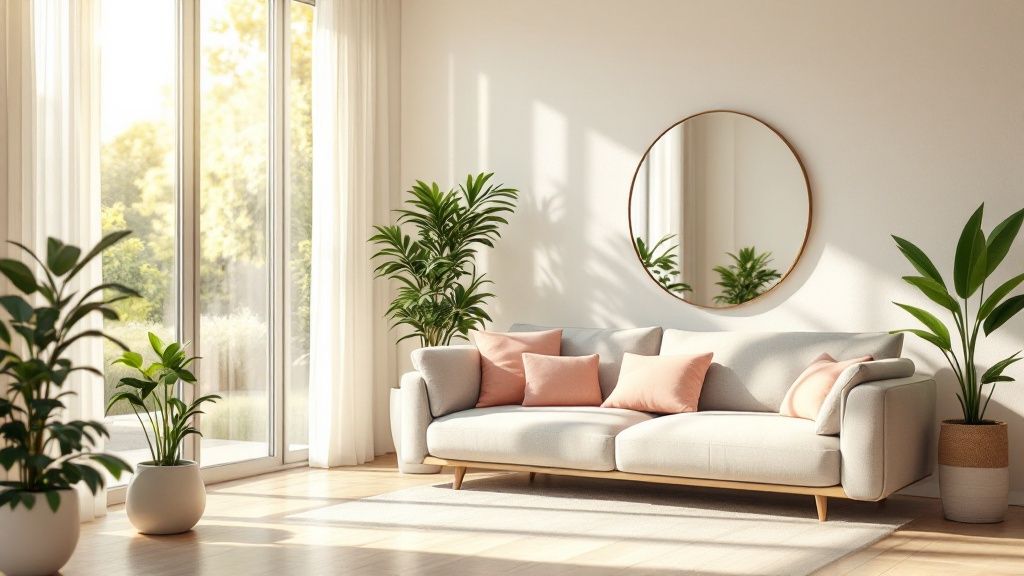
Transform Your Gloomy Space into a Light-Filled Haven
Does a dark room in your home feel uninviting? Learn how to brighten a dark room with these seven effective strategies. This guide provides practical tips, from simple décor adjustments to larger renovations, to maximize natural light and create a brighter, more welcoming space. Discover how strategic mirror placement, layered lighting, reflective paint colours, window treatments, flooring choices, décor, and smart lighting systems can transform your home. These improvements not only enhance aesthetics but also increase comfort and value.
1. Brighten with a Skylight
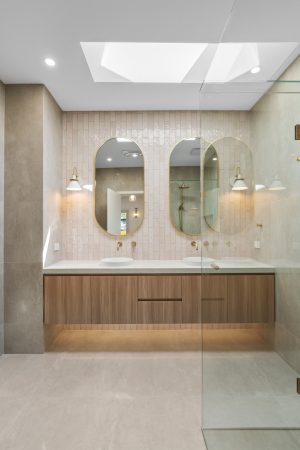
Natural light isn’t just a luxury—it’s a game-changer for your home’s ambiance, energy, and value. If your interior feels dull or closed in, a skylight offers a powerful solution. Vivid Skylights, an Australian innovator in high-quality skylight solutions, has perfected the art of turning dark spaces into bright, uplifting environments.
A Vivid Skylight instantly transforms kitchens, hallways, bathrooms, or living rooms by flooding them with daylight. Unlike traditional windows that offer limited reach, skylights direct sunlight into the heart of the home. The result? Enhanced mood, improved visual appeal, and even reduced energy costs by relying less on artificial lighting.
Vivid Skylights are engineered with sleek, minimalist profiles that complement both modern and traditional designs. Their fixed skylight systems are constructed with durable, double-glazed glass to maximise insulation and energy efficiency. Whether you’re renovating or building new, their streamlined installation process and compatibility with most roof types make them a smart, practical choice.
But this isn’t just about aesthetics—it’s a lifestyle shift. Natural light has been shown to boost productivity, elevate mood, and even regulate sleep patterns. Imagine preparing meals under natural sunshine, or starting your day with soft, diffused light instead of flicking on fluorescent bulbs.
Visit www.vividskylights.com.au to explore available sizes, view project inspiration, and find the perfect skylight to match your vision. Their team offers expert advice and support to ensure seamless installation and lasting satisfaction.
A gloomy space is a missed opportunity. A Vivid Skylight is your first step toward a home that feels larger, warmer, and undeniably alive.
2. Strategic Mirror Placement
One of the most effective ways to brighten a dark room without undertaking expensive electrical work is through strategic mirror placement. This technique involves positioning mirrors to reflect and amplify existing light sources, both natural and artificial, creating the illusion of a brighter and more spacious area. Mirrors essentially “double” the perceived light by bouncing it around the room, mimicking the effect of additional windows and expanding the visual depth. This simple trick can dramatically transform a dim, uninviting space into a light and airy haven.
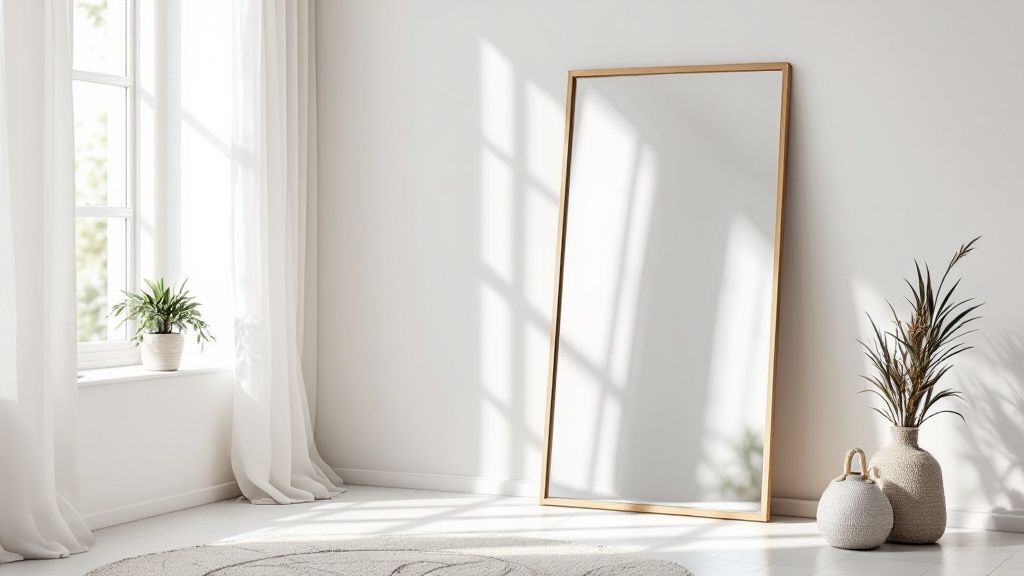
This method offers a range of benefits, making it a popular choice for homeowners and interior designers alike. Mirrors come in a variety of sizes, shapes, and frame styles, offering flexibility for different design aesthetics and budgets. They can be mounted on walls, leaned against them, or placed on furniture like mirrored coffee tables or consoles. This versatility makes them suitable for any room, from small bedrooms and basement apartments to larger living spaces. For example, mirrored closet doors can create the illusion of more space in a cramped bedroom, while a large mirror opposite a window can effectively distribute natural light throughout a living room. Even something as simple as a strategically placed dressing table mirror can make a noticeable difference in how bright a room feels. The historical example of the Hall of Mirrors at Versailles beautifully illustrates this principle, demonstrating how mirrors can dramatically amplify even candlelight.
Thinking of incorporating a vintage touch? Mirrors can significantly amplify natural light and create the illusion of more space. For inspiration on how to effectively use vintage mirrors in your design, check out this resource: incorporating vintage mirrors.
While strategic mirror placement is a cost-effective and visually appealing solution for how to brighten a dark room, it does have a few potential drawbacks. Large or heavy mirrors require secure mounting to prevent accidents, and positioning a mirror directly opposite a window can create unwanted glare. Additionally, mirrors are less effective in rooms with minimal existing light sources, as they can only amplify what’s already present. Finally, while smaller mirrors can be relatively inexpensive, high-quality, large mirrors can be a significant investment. Regular cleaning is also necessary to maintain optimal reflectivity and prevent dust buildup.
Tips for Successful Mirror Placement:
- Maximize Natural Light: Position mirrors directly across from windows to reflect the maximum amount of natural light into the room.
- Consider Proportions: Choose a mirror size that is proportional to your wall space. A large mirror on a small wall can feel overwhelming, while a small mirror on a large wall might get lost.
- Even Distribution: Angle mirrors toward dark corners to distribute light more evenly throughout the space.
- Layered Reflection: Create a gallery wall of smaller mirrors for both aesthetic appeal and increased light reflection.
- Maintain Reflectivity: Clean mirrors regularly to maintain maximum light reflection.
Strategic mirror placement deserves its place on this list because it offers a simple, affordable, and instantly effective way to brighten a dark room. It’s a versatile solution that can be adapted to various spaces and styles, offering both functional and decorative benefits. By carefully considering the size, shape, and placement of your mirrors, you can transform a dark, uninviting space into a bright and welcoming one.
3. Layered Lighting Strategy
One of the most effective ways to brighten a dark room and enhance its ambience is by implementing a layered lighting strategy. This approach goes beyond simply installing a single overhead fixture. Instead, it combines ambient (general), task, and accent lighting to create depth, dimension, and a brighter, more inviting space. This comprehensive approach ensures adequate illumination for various activities while adding visual interest and eliminating those gloomy shadows that can make a room feel small and unwelcoming.

A layered lighting scheme incorporates multiple light sources at different heights and locations. This typically includes ceiling fixtures for overall illumination, floor lamps to provide a soft, diffused light, table lamps for focused task lighting, and strategically placed accent lights to highlight architectural features or artwork. Imagine a living room with recessed downlights providing ambient light, a floor lamp casting a warm glow behind the sofa, and a table lamp illuminating a reading nook. This is layered lighting in action! This strategy can be further enhanced with smart lighting systems like Philips Hue, allowing you to control individual lights or groups of lights, adjust brightness, and even change the colour temperature to suit the mood and time of day. The flexibility this offers is a game-changer for how you interact with your living space.
This approach is ideal for any room in your home, from living rooms and kitchens to bedrooms and home offices. In a kitchen, recessed lighting can provide general illumination, under-cabinet lighting can brighten work surfaces, and pendant lights over the island can create a focal point. In a home office, a combination of ceiling lights, a desk lamp, and accent lighting for bookshelves creates a productive yet comfortable environment. Even Australian homeowners dealing with limited natural light can dramatically improve the brightness and feel of their homes with a well-designed layered lighting plan.
Pros:
- Creates a flexible lighting environment for different activities
- Eliminates harsh shadows and dark corners
- Adds depth and dimension to the room
- Can highlight architectural features and artwork
- Creates a more inviting and comfortable atmosphere
Cons:
- Higher initial investment for multiple fixtures
- May require professional electrical work for complex installations
- Increased energy consumption (mitigated by using energy-efficient bulbs)
- Requires thoughtful planning and coordination of fixtures
- Can look cluttered if not well-designed
Tips for Implementing a Layered Lighting Strategy:
- Aim for at least three light sources per room at varying heights.
- Use dimmers to control the intensity and mood of your lighting.
- Choose fixtures that direct light both upward and downward to create a more balanced and brighter space.
- Plan lighting around the room’s main functions and focal points.
- Consider colour temperature: warmer lights (2700-3000K) for living spaces and cooler lights (3500-4000K) for work areas.
The layered lighting approach, popularized by designers like Lindsey Adelman and Thomas O’Brien, and showcased in spaces like the Soho House clubs and Restoration Hardware showrooms, deserves its place on this list because it offers a comprehensive and highly effective solution to brightening a dark room. It transforms a space from flat and dull to dynamic and welcoming, enhancing both its functionality and aesthetic appeal.
4. Light-Reflective Paint Colours
One of the most effective and affordable ways to brighten a dark room is by using light-reflective paint colours. This method leverages specially formulated paints with high Light Reflectance Values (LRVs) to maximise the amount of light bouncing around the space. Instead of absorbing light, these paints reflect it, creating a brighter, more open feel. This simple change can dramatically improve the ambience of any room, especially those with limited natural light, making it a worthy addition to this list.
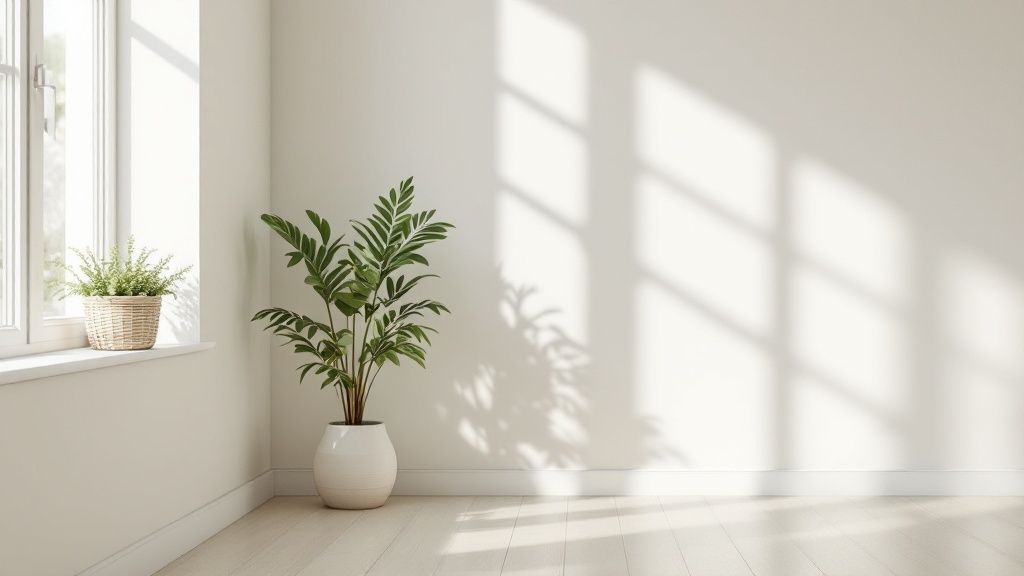
These paints achieve their light-boosting properties through high LRV ratings, typically between 75 and 100 on a scale of 0 (absolute black) to 100 (pure white). They are available in various sheen levels, from flat to high-gloss, and typically come in whites, off-whites, pale yellows, and light greys. Some formulations even incorporate light-reflective particles for enhanced brightness. These paints can be applied to walls, ceilings, and trim, providing a holistic approach to brightening a room.
Why Choose Light-Reflective Paint?
This approach offers several advantages over other methods of brightening a dark room:
- Cost-effective: Compared to structural changes like adding windows or skylights, using light-reflective paint is a significantly more affordable option.
- Immediate impact: You’ll see a noticeable difference in brightness immediately after the paint dries.
- Energy-efficient: Unlike artificial lighting, light-reflective paint works continuously without consuming any energy.
- Space-enhancing: Lighter colours can make small rooms appear larger and more open.
- Easy to update: If you decide to change your colour scheme later, it’s relatively easy to repaint.
Weighing the Pros and Cons:
While light-reflective paint offers many benefits, it’s important to consider the potential drawbacks:
- Visibility of imperfections: Lighter colours can highlight imperfections on walls and ceilings. Proper wall preparation is crucial for a smooth finish.
- Potential for a cold feel: Without careful styling, light colours can sometimes feel cold or clinical. Adding warm textures and furnishings can mitigate this.
- Multiple coats: Achieving full coverage may require multiple coats, especially when painting over darker colours.
- Glare: High-gloss finishes can create unwanted glare, particularly in rooms with direct sunlight.
Tips for Success:
- Sheen selection: Opt for semi-gloss or satin finishes for increased light reflection.
- Ceiling strategy: Paint ceilings one shade lighter than walls to create an illusion of height.
- Colour temperature: Choose cool whites for modern spaces and warm whites for traditional rooms.
- Testing is key: Test paint samples in different lighting conditions before committing to a colour.
- Seamless expansion: Extend the light paint to trim and doors for a cohesive and expansive look.
Examples in Australian Homes:
Light-reflective paints are gaining popularity in Australia, particularly in minimalist and Scandinavian-inspired designs. Imagine Benjamin Moore’s ‘Simply White’ brightening a north-facing room in Melbourne, or Farrow & Ball’s ‘All White’ creating a serene atmosphere in a Sydney apartment. Even in basement renovations, paints like Sherwin-Williams’ ‘Reflective White’ can dramatically improve the perceived brightness. For apartments with limited natural light, Behr’s ‘Ultra Pure White’ can be a game-changer.
By understanding the principles of light reflection and choosing the right paint, you can transform a dark and dreary room into a bright and inviting space. This simple yet effective strategy can significantly enhance the comfort and aesthetic appeal of your home.
5. Strategic Window Treatment Selection
One of the most effective ways to brighten a dark room without undertaking major renovations is through strategic window treatment selection. This approach focuses on maximizing natural light entry while maintaining privacy and insulation. It involves carefully choosing window coverings based on material transparency, mounting techniques, and operational flexibility to control light flow throughout the day. This method deserves its place on the list because it offers a relatively simple, cost-effective, and impactful solution for improving natural light in any space.
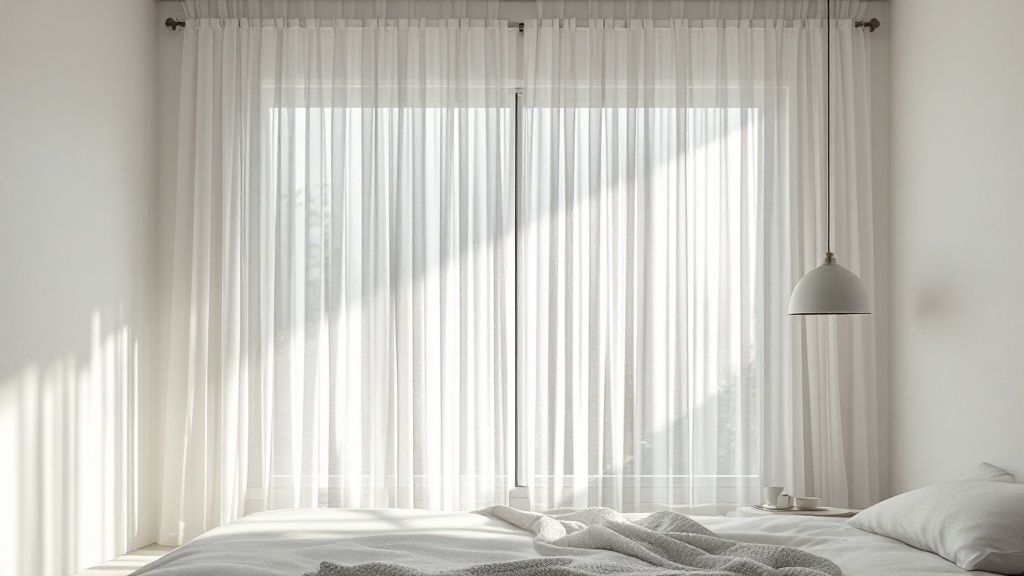
By understanding how different fabrics, styles, and installation methods affect light distribution, you can dramatically transform a dim room into a bright and inviting space. For instance, sheer or light-filtering fabrics diffuse light beautifully, creating a soft, ambient glow. Adjustable options like blinds, shutters, or layered treatments (e.g., sheers paired with drapes) provide flexibility in controlling the amount of light and privacy throughout the day. Outside-mount installations, where the treatments are mounted outside the window frame, maximize glass exposure and allow more light to enter. Light-coloured or reflective materials further enhance brightness by bouncing light back into the room. Minimising hardware profiles keeps the focus on the window and the light it brings in.
Consider a few practical examples. Top-down/bottom-up cellular shades are a great choice for urban apartments, offering privacy at the bottom while allowing natural light to filter in from the top. Sheer white curtains, a classic in Parisian apartments, create an airy and luminous atmosphere. Café curtains, often seen in kitchen windows, provide bottom privacy while maximizing light entry from the top half of the window. In modern offices, roller blinds with light-filtering fabrics offer a sleek and functional solution.
Tips for Maximizing Natural Light with Window Treatments:
- Mount curtain rods wider and higher than the window frames: This creates the illusion of larger windows and allows more light to enter.
- Layer treatments: Combining sheers behind drapes or blinds offers maximum flexibility in light control and privacy.
- Choose curtain fabrics with less than 3% opacity: This ensures maximum light filtration while still providing some privacy.
- Consider motorized options for hard-to-reach windows: Motorized blinds or shades make adjusting light levels easy and convenient.
- Use tie-backs or holdbacks: These allow you to maximize light entry during the daytime by pulling curtains or drapes away from the window.
Pros and Cons of Strategic Window Treatment Selection:
Pros:
- Preserves privacy while allowing natural light
- Adaptable to changing light conditions throughout the day
- Less expensive than structural modifications
- Provides UV protection for furniture
- Enhances window appearance and room aesthetics
Cons:
- Quality treatments can be expensive
- Some options require professional installation
- May still block some light even in open positions
- Light-filtering materials offer less nighttime privacy
- Requires regular cleaning
Popular brands like The Shade Store, Hunter Douglas, and Smith & Noble offer custom window covering solutions, while designers like Kelly Wearstler showcase the elegant use of sheer drapery. Restoration Hardware’s Belgian linen curtain collections are another popular choice. By focusing on strategic window treatment selection, you can significantly brighten a dark room and transform its ambience without resorting to expensive and complex renovations.
6. Light-Enhancing Flooring Options
One of the most impactful yet often overlooked ways to brighten a dark room is by strategically choosing your flooring. This technique, focusing on light-enhancing flooring options, leverages the largest surface area in your room – the floor – to reflect natural and artificial light upwards, dramatically increasing the perceived brightness. If you’re looking for how to brighten a dark room, this is a fundamental step that can transform your space.
Light-enhancing flooring involves selecting materials, colours, and finishes that effectively bounce light around the room. This isn’t just about choosing a light colour; it’s about understanding how different materials and finishes interact with light. High-gloss or semi-gloss finishes, for example, reflect significantly more light than matte finishes. Similarly, light-coloured materials like blonde wood, white tiles, or pale carpets naturally reflect more light than darker counterparts. Even materials like polished concrete or glazed porcelain can contribute to a brighter space thanks to their reflective properties. Some flooring options even incorporate metallic or glass components for enhanced reflection, adding a touch of modern elegance while boosting the light in the room.
Examples of Successful Implementation:
- Scandinavian Homes: White oak floors finished with matte polyurethane are a staple in Scandinavian design, creating a bright and airy feel.
- Modern Penthouses: Large-format white porcelain tiles are a popular choice in modern penthouses, reflecting light and adding a sense of luxury.
- Industrial Loft Conversions: Polished concrete floors contribute to the industrial aesthetic while maximizing light reflection in these often open-plan spaces.
- Beach Houses: Bleached hardwood floors create a relaxed, sun-drenched vibe, perfectly complementing the coastal aesthetic.
Actionable Tips for Brighter Floors:
- Area Rugs: Layer area rugs over light-coloured floors for added warmth and texture. These can be easily changed seasonally to update the look and feel of the room.
- Semi-Gloss Finish: Opt for a semi-gloss finish instead of high-gloss to achieve a balance between light reflection and practicality. High-gloss can be slippery when wet.
- Strategic Floor Lamp Placement: Place floor lamps strategically to bounce light off the floor and amplify the brightness.
- Rental-Friendly Solution: If you’re renting and can’t change the flooring, large, light-coloured area rugs can significantly brighten a dark room with dark floors.
- Regular Cleaning: Maintain regular cleaning to preserve the reflective properties of your flooring and prevent dust and dirt from dulling the shine.
Pros and Cons of Light-Enhancing Flooring:
Pros:
- Maximizes light reflection using the largest surface area in the room.
- Creates a foundation for a brighter overall space.
- Many options are durable and long-lasting.
- Can make spaces appear larger and more open.
- Energy-efficient, as it works passively without consuming electricity.
Cons:
- Can be more expensive to change than paint or decor.
- Light colours may show dirt and stains more easily.
- Installation often requires professional help.
- High-gloss finishes can be slippery when wet.
- May clash with existing furniture or design elements.
Why This Approach Deserves Its Place in the List:
Light-enhancing flooring is a fundamental element in brightening a dark room because it addresses the largest surface area in the space. While paint and decor can contribute, the floor plays a crucial role in reflecting and distributing light. This method offers a long-term, passive solution that works continuously without any energy consumption, making it both aesthetically pleasing and practical. This approach is particularly effective in the AU region, where maximizing natural light is often a key consideration due to the abundance of sunshine. Inspired by designers like Sarah Sherman Samuel (known for her signature blonde wood floors) and influenced by Italian tile manufacturers like Florim and Marazzi, as well as the broader Scandinavian design movement, this technique has become increasingly popular in modern homes. High-contrast interior designs, as championed by Kelly Wearstler, also often utilize reflective flooring to maximize the impact of light and shadow. Choosing the right flooring is an investment that can significantly enhance the brightness, spaciousness, and overall ambience of your home.
7. Light-Amplifying Decor and Accessories
Want to know how to brighten a dark room without undertaking major renovations? Light-amplifying decor and accessories offer a brilliant solution, especially for renters or those on a budget. This method leverages reflective materials, light colours, and strategic placement to maximise the impact of existing light sources, effectively bouncing light around the room and creating a brighter, more inviting atmosphere. This approach is perfect for anyone looking to enhance natural light and make a dark room feel more airy and spacious.
This technique works by utilising surfaces that reflect light, rather than absorb it. Think metallic finishes, glass, crystals, and even polished wood. These materials catch and scatter light, amplifying its reach within the room. Light-coloured textiles, such as upholstery and curtains, further contribute to this effect by reflecting rather than absorbing light. Even incorporating transparent or translucent furniture pieces can help light penetrate deeper into the space.
Features to Consider:
- Reflective Surfaces: Metal (silver, gold, chrome, brass), glass, crystal, mirrored surfaces, and polished wood.
- Light-Coloured Textiles: Pale upholstery, curtains, rugs, and throws.
- Transparent/Translucent Furniture: Acrylic or glass tables, Lucite chairs, glass shelving.
- Metallic Accents: Incorporate these in lamps, picture frames, hardware, and decorative objects.
- Reflective Artwork: Pieces with metallic elements or glass frames.
Pros:
- Easily Changeable and Adaptable: Update your decor as trends change or your needs evolve.
- Budget-Friendly: Implement gradually and affordably, incorporating pieces over time.
- Non-Permanent: Ideal for renters or those hesitant about structural changes.
- Dual Purpose: Items are both functional and aesthetically pleasing.
- Seasonal Flexibility: Adjust accessories to suit the changing light throughout the year.
Cons:
- Less Impactful: While effective, this method won’t be as transformative as adding a skylight or enlarging a window.
- Requires Maintenance: Regularly clean reflective surfaces to maintain their optimal light-bouncing properties.
- Risk of Overdoing It: Too many reflective elements can create a cluttered or overwhelming feel.
- Cost of Quality: High-quality reflective pieces can be expensive, although budget-friendly options are readily available.
- Limited Impact in Very Dark Spaces: This method may not be sufficient for rooms with minimal natural light.
Examples in Australian Homes:
- Lucite coffee tables: Add a touch of modern elegance and light reflection to smaller apartments, particularly common in trendy inner-city areas like Sydney and Melbourne.
- Mercury glass lamps and accessories: Introduce a vintage-inspired shimmer to traditional homes, reflecting light beautifully in spaces like living rooms and bedrooms.
- Brass and gold accents in mid-century modern interiors: Complement the warm tones and clean lines of this style, enhancing light reflection in popular open-plan living spaces.
- Glass-topped dining tables: Maximise light and create a sense of spaciousness in compact dining areas, perfect for terrace homes or apartments.
Actionable Tips:
- Strategic Placement: Group reflective objects near light sources, such as windows or lamps, to maximise their impact.
- Balance and Texture: Combine reflective elements with soft textiles like rugs and cushions to avoid a cold, sterile feeling.
- Gallery Walls: Use metallic picture frames to create an eye-catching display that also reflects light.
- Kitchen Considerations: Opt for glass-front or mirrored cabinet doors to brighten a kitchen and create an illusion of more space.
- Subtle Reflections: Incorporate textiles with metallic thread for a subtle yet effective way to enhance light reflection.
Inspiration from Leading Designers:
Inspiration for light-amplifying decor can be found in the work of designers like Jonathan Adler (known for his reflective home accessories), West Elm (with its mixed metal decor collections), CB2 (featuring acrylic and glass furniture), Kelly Wearstler (who masterfully uses metallic accents), and Restoration Hardware (known for their mirror and crystal lighting collections).
Light-amplifying decor deserves its place on this list because it provides a practical, accessible, and stylish solution for brightening a dark room without resorting to costly or complex renovations. By carefully selecting and placing reflective elements, you can significantly enhance the natural light in your space and create a brighter, more welcoming atmosphere.
8. Smart Lighting Automation Systems
Want to effortlessly brighten a dark room and transform its ambience with a tap on your phone? Smart lighting automation systems offer a sophisticated and highly effective solution for optimizing brightness, whether you’re dealing with a dimly lit living room or a gloomy home office. These systems use programmable, internet-connected lighting fixtures and controls to adjust brightness based on the time of day, whether the room is occupied, and your personal preferences. This makes them a powerful tool in your arsenal for how to brighten a dark room, especially if you value convenience and customisation.
Smart lighting automation works by creating a network of interconnected lights and sensors. These communicate with a central hub (or sometimes directly to your WiFi router) and can be controlled through a smartphone app, voice commands, or pre-set schedules. Imagine waking up to gradually increasing light levels mimicking a natural sunrise, or having lights automatically turn on as you enter a room. These systems can even adjust colour temperature throughout the day, promoting alertness during the day and relaxation in the evening.
Examples of Successful Implementation:
- Modern Smart Homes: Philips Hue is a popular choice, allowing you to create vibrant lighting scenes and integrate with other smart home devices. Picture coloured accent lighting synchronised with your music for entertaining, or a calming blue hue for bedtime.
- Renovated Historic Homes: Lutron Caseta systems offer a reliable and scalable solution, often preferred for retrofitting older homes due to their compatibility with various wiring configurations.
- Rental Apartments: LIFX bulbs provide a portable smart lighting option, allowing renters to easily upgrade their lighting without major installations.
- Commercial Applications: Crestron systems are commonly used in offices and commercial spaces to manage complex lighting setups and optimize energy efficiency.
Actionable Tips for Brightening Your Room with Smart Lighting:
- Start Small: Begin with one room to test the system and familiarise yourself with the features.
- Consider a Hub: Hub-based systems generally offer more reliable performance and greater control compared to WiFi-only bulbs.
- Mimic Natural Light: Use colour temperature automation to match daylight cycles. Cooler tones during the day boost productivity, while warmer tones in the evening create a relaxing atmosphere.
- Motion Sensors in Transitional Spaces: Install motion sensors in hallways and entryways for automatic lighting control.
- Create Custom Scenes: Set specific scenes for different activities, like “Working,” “Relaxing,” or “Entertaining.”
- Voice Control Integration: Look for systems compatible with your preferred voice assistant, such as Amazon Alexa or Google Home.
Pros and Cons of Smart Lighting Automation:
Pros:
- Precise control over lighting intensity and distribution
- Adapts to changing daylight conditions automatically
- Can reduce energy consumption through intelligent scheduling
- Convenient remote operation
- Creates customized lighting scenes for different activities
- Future-proof with regular software updates
Cons:
- Higher initial investment than conventional lighting
- May require professional installation (depending on the complexity)
- Dependent on reliable WiFi connection
- Learning curve for programming and operation
- Potential compatibility issues between different systems
- Privacy concerns with some cloud-connected systems
Why Smart Lighting Deserves a Place on this List:
Smart lighting automation offers a unique combination of convenience, customisation, and energy efficiency. It goes beyond simply brightening a dark room by providing dynamic control over every aspect of your lighting environment. While the initial cost might be higher than traditional lighting, the long-term benefits of optimized energy usage and enhanced living experience make it a valuable investment, especially for homeowners in the AU region with increasing energy costs. By intelligently managing your lighting, you can create a brighter, more comfortable, and more inviting space while also reducing your environmental impact.
8-Key Strategies Comparison
| Strategy | Implementation Complexity 🔄 | Resource Requirements 💡 | Expected Outcomes 📊 | Ideal Use Cases 💡 | Key Advantages ⭐ |
| Vivid Skylight | Requires some trade knowledge | Moderate | High – x3 times more light than a window | Anywhere in the home | Improve property value, Natural light, customizable |
| Strategic Mirror Placement | Low – simple mounting or freestanding | Low – cost of mirrors, possible mounting | Moderate – brightens room, adds depth | Rooms with existing light, small spaces | Cost-effective, instant effect, decorative |
| Layered Lighting Strategy | High – multiple fixtures & wiring | High – various fixtures, possible pro install | High – flexible, shadow-free, dimensional | Multifunctional rooms needing varied lighting | Highly customizable, enhances mood & function |
| Light-Reflective Paint Colors | Low – standard painting process | Moderate – specialized paint costs | Moderate – continuous brightness boost | Small/dark rooms, easy updates | Inexpensive, enlarges space visually |
| Strategic Window Treatment | Moderate – selection & installation | Moderate – cost of treatments, possible install | Moderate – maximizes natural light while preserving privacy | Urban apartments, privacy-sensitive spaces | Controls light & privacy, UV protection |
| Light-Enhancing Flooring Options | High – flooring replacement/upgrade | High – material and installation costs | High – significant and lasting brightness increase | Major renovations, high-traffic/light needs | Durable, enlarges space, continuous effect |
| Light-Amplifying Decor & Accessories | Low – adding/changing decor | Low to moderate – cost varies by pieces | Low to moderate – subtle light boost | Renters, budget-conscious, incremental update | Flexible, dual-purpose, renter-friendly |
| Smart Lighting Automation Systems | High – tech setup and programming | High – smart devices, possible pro install | High – adaptive, energy-efficient lighting | Tech-savvy homes, energy-conscious users | Precise control, convenience, energy savings |
Let There Be Light: Brightening Your Home for a Brighter Mood
Transforming a dark room into a vibrant, inviting space is easier than you think. By strategically implementing these eight brightening techniques—from a SKYLIGHT installation, mirror placement and layered lighting to light-reflective paint colours and smart lighting automation—you can significantly enhance the ambiance and functionality of any room in your Australian home. Whether you’re a homeowner looking for a quick refresh, a renovator undertaking a major project, or an architect designing a new build, understanding how to brighten a dark room is crucial for creating comfortable and appealing spaces. Mastering these concepts allows you to maximise natural light, create the illusion of spaciousness, and positively impact mood and well-being. Even small changes, like choosing lighter flooring or strategically placed accessories, can make a noticeable difference. The most important takeaway is that a brighter room isn’t just about aesthetics; it’s about creating a healthier, more enjoyable living environment.
For a truly transformative solution to how to brighten a dark room, consider the unparalleled benefits of natural light. Vivid Skylights offers a stunning and practical way to flood even the darkest spaces with beautiful, energy-efficient illumination. Visit Vivid Skylights today to explore how their innovative skylight solutions can bring the brilliance of natural light into your home.
